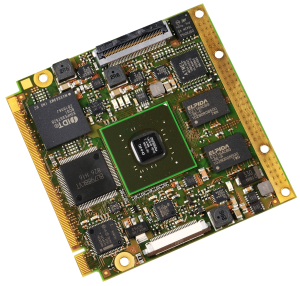First Tegra 2-based Qseven module spins HD video on 5 Watts
Feb 23, 2011 — by Eric Brown — from the LinuxDevices Archive — 6 viewsMSC Vertriebs announced an ARM-based Qseven module that appears to be the industry's first such device using Cortex-A9 cores. The MSC Q7-NT2 is built around a dual-core 1GHz Nvidia Tegra 290 processor, supports 1080p video, offers interfaces ranging from gigabit Ethernet to I2C, consumes only five Watts, and offers extended temperature support, says the company.
With its Tegra 2 processor and extended temperature support, the MSC Q7-NT2 is particularly suitable for digital signage, but it also supports medical and industrial visualization applications, as well as image processing, multimedia, and Internet TV applications, MSC Vertriebs says.
The module is supported with board support packages for Linux and Windows CE, and the company suggests it will also support future Windows versions that support the ARM architecture. Carrier boards, meanwhile, are said to be "coming soon."

MSC Q7-NT2
In Feb. 2010, iWave Systems announced an iW-i.MX51 module — based on Freescale's i.MX51 SoC — that used the same MXM (Mobile PCI Express Module) connectors as Qseven but apparently did not implement the Qseven bus. According to MSC Vertriebs, the Qseven spec only began offering support for the ARM/RISC processor in September with Revision 1.12. (See farther below for more on Qseven.)
The MSC Q7-NT2 builds upon the Nvidia Tegra 290, an updated version of the original Tegra 250 (Tegra 2) processor that's much loved by Android tablet makers. Equipped with dual 1GHz Cortex-A9 cores, the Tegra 2 offers an integrated GeForce 3D graphics controller with support for OpenGL ES 2.0, and supports MPEG4/H.264 video encoding at D1 resolution, and decoding at full HD 1920 x 1080 pixels, says the company.
The processor is assisted by up to 1GB DDR2 SDRAM and up to 8GB of flash storage, says MSC. An HDMI 1.3 interface is provided, along with an optional dual-channel LVDS interface, enabling dual-display capability. A camera can also be connected via an 8-bit BT.656 video input available on a feature connector, the company adds.
The MSC Q7-NT2 offers three PCI Express (PCIe) channels, a gigabit Ethernet interface, and two optional SATA II interfaces, says MSC. Up to four USB 2.0 hosts and a USB On-The-Go port are said to be available, along with a serial UART interface. Also supplied is I2C (400Kbit/s) and SPI, among other interfaces, most of which are offered via the Qseven "golden finger" connector.
The module supports temperatures of -40 to 185 deg. F (-40 to 85 deg. C), says the company. Typical power consumption is said to be 5 Watts.
Features and specifications for the MSC Q7-NT2 include:
- Processor — Nvidia Tegra 290 (2 x 1GHz Cortex-A9 cores) with GeForce 3D graphics
- Memory — up to 1GB DDR2 SDRAM (soldered); up to 8GB NAND flash
- Flash expansion — 1 x MMC/SD
- Expansion — up to 3 x PCIe
- Storage — 2 x SATA II interfaces (optional)
- Networking — 1 x gigabit Ethernet
- Other I/O:
- Up to 4 x USB 2.0 host
- 1 x USB OTG
- HDMI 1.3
- optional dual-channel LVDS with dual display
- 1 x UART debug port
- 8-bit camera interface on feature connector
- I2C bus up to 400kbit/
- SPI interface
- 1 x AC97 audio interface
- Other features — ID EEPROM (2Kbit) on I2C bus; real-time clock
- Power — +5 V +/-5%, 5 V standby; 5 W typical consumption
- Operating temperature — -40 to 185 deg. F (-40 to 85 deg. C)
- Dimensions — 2.75 x 2.75 inches (70 x 70mm); Qseven format
- Operating system — Linux; Windows CE
About Qseven
Qseven is a COM standard released in 2008 by a 14-member consortium led by Congatec, MSC Vertriebs, and Seco. Promoted as ideal for mobile devices, the 70 x 70mm format includes "fast serial differential interfaces," including PCI Express and Serial ATA, while skipping support for legacy interfaces like EIDE and PCI. It also supports SDIO, plus newfangled graphics and digital media specs such as DisplayPort and HDMI.
The Qseven golden finger connector was originally designed for laptop graphics cards using Nvidia's MXM (Mobile PCI Express Module) format. The connector, re-purposed here as a CPU module interconnect, provides 230 positions, .020-inch pitch, and 5.5mm and 7.8mm height options.
Availability
No pricing or availability information was provided for the MSC Q7-NT2. More information may be found at MSC Vertriebs' MSC Q7-NT2 page.
This article was originally published on LinuxDevices.com and has been donated to the open source community by QuinStreet Inc. Please visit LinuxToday.com for up-to-date news and articles about Linux and open source.